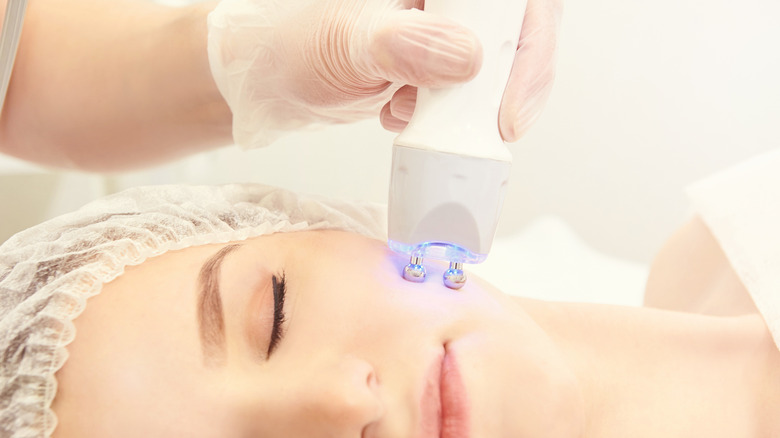The Real Difference Between Microcurrent And Radio Frequency Facial Treatments
There's a new skincare craze and, believe it or not, it has a rather futuristic vibe to it. While the concept of using a new, technologically-inspired facial treatment as a form of self-care might seem strange, these new skincare treatments are changing the face of non-invasive skincare (per Vogue).
The truth is that, when it comes to our skincare, we want results fast. While there are cosmetic treatments that offer quick results, they're usually invasive, whereas microcurrent and radio frequency facials are not, which is part of what's making these edgy treatments so popular with skincare enthusiasts.
As per iBeautyMachine, the microcurrent facial uses a low-level current that ranges from 0 to 400 microamps to get results, and the radio frequency treatment uses frequency to transfer heat to the skin, causing a reaction that aims to boost skin health.
A lot of people get confused between the two treatments, and with the sci-fi inspired theme running through both skincare treatments, it's easy to see why. However, there is a significant difference between how the two treatments work and what issues they target.
What are radio frequency and microcurrent facial treatments and what are the differences between them?
As per Vogue, facial plastic surgeon and cosmetic doctor, Dr. Maryam Zamani, explains that, "Radiofrequency is essentially a bulk way of heating the skin, it helps to promote collagen synthesis, whereas microcurrent is an energy source that stimulates the facial muscles, which can give a toned and lifted appearance."
According to 7E Wellness, radio frequency is a form of energy that is measured by wavelengths per second — it's kind of similar to the sound waves that a smartphone emits or how WiFi signals work. It's part of the electromagnetic spectrum.
What's unique about radio frequency is that it can produce heat, which, when applied to the layers of the skin, can help to encourage the skin to produce more collagen and elastin, both of which help to keep skin looking younger for longer.
NEWA Radio Frequency explained to 7E Wellness that, "when the treated area reaches its optimum temperature of 52-55 degrees celsius, it pushes back together your collagen fibers and increases elastin production, the protein that improves elasticity in your skin."
How microcurrent facial therapy works can sound a little daunting, as a low-level of electric current is used to mimic the body's natural current. This treatment is designed to target facial muscles, re-training them as a method for tightening skin and smoothing the complexion.
According to 7E Wellness, microcurrent treatment is great for helping to tighten skin that sags, reducing the appearance of the signs of aging, such as fine lines and wrinkles, and improving the skin's texture.
While radio frequency treatment encourages cell turnover, alongside making the skin look and feel tighter, microcurrent treatment focuses on making the muscle itself tighter.
Another key difference between the two treatments is that, while radio frequency treatment uses an electrical current to create heat that causes the cells within the skin to react, microcurrent treatment instead uses currents to mimic the natural processes that already exist within the body.

